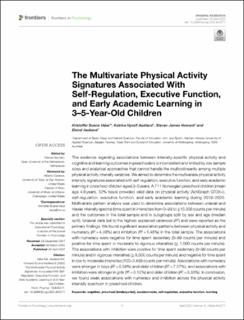| dc.contributor.author | Vabø, Kristoffer Buene | |
| dc.contributor.author | Aadland, Katrine Nyvoll | |
| dc.contributor.author | Howard, Steven James | |
| dc.contributor.author | Aadland, Eivind | |
| dc.date.accessioned | 2022-09-28T13:41:23Z | |
| dc.date.available | 2022-09-28T13:41:23Z | |
| dc.date.created | 2022-05-30T09:40:41Z | |
| dc.date.issued | 2022 | |
| dc.identifier.citation | Vabø, K. B., Aadland, K. N., Howard, S. J., & Aadland, E. (2022). The Multivariate Physical Activity Signatures Associated With Self-Regulation, Executive Function, and Early Academic Learning in 3–5-Year-Old Children. Frontiers in Psychology, 13:842271. | en_US |
| dc.identifier.issn | 1664-1078 | |
| dc.identifier.uri | https://hdl.handle.net/11250/3022335 | |
| dc.description.abstract | The evidence regarding associations between intensity-specific physical activity and cognitive and learning outcomes in preschoolers is inconsistent and limited by low sample sizes and analytical approaches that cannot handle the multicollinearity among multiple physical activity intensity variables. We aimed to determine the multivariate physical activity intensity signatures associated with self-regulation, executive function, and early academic learning in preschool children aged 3–5 years. A 711 Norwegian preschool children (mean age 4.6 years, 52% boys) provided valid data on physical activity (ActiGraph GT3X+), self-regulation, executive function, and early academic learning during 2019–2020. Multivariate pattern analysis was used to determine associations between uniaxial and triaxial intensity spectra (time spent in intensities from 0–99 to ≥15,000 counts per minute) and the outcomes in the total sample and in subgroups split by sex and age (median split). Uniaxial data led to the highest explained variances (R2) and were reported as the primary findings. We found significant association patterns between physical activity and numeracy (R2 = 4.28%) and inhibition (R2 = 1.48%) in the total sample. The associations with numeracy were negative for time spent sedentary (0–99 counts per minute) and positive for time spent in moderate to vigorous intensities (≥ 1,000 counts per minute). The associations with inhibition were positive for time spent sedentary (0–99 counts per minute) and in vigorous intensities (≥ 8,500 counts per minute) and negative for time spent in low to moderate intensities (100–3,499 counts per minute). Associations with numeracy were stronger in boys (R2 = 5.58%) and older children (R2 = 7.27%), and associations with inhibition were stronger in girls (R2 = 3.12%) and older children (R2 = 3.33%). In conclusion, we found weak associations with numeracy and inhibition across the physical activity intensity spectrum in preschool children. | en_US |
| dc.language.iso | eng | en_US |
| dc.publisher | Frontiers Media | en_US |
| dc.rights | Navngivelse 4.0 Internasjonal | * |
| dc.rights.uri | http://creativecommons.org/licenses/by/4.0/deed.no | * |
| dc.title | The Multivariate Physical Activity Signatures Associated With Self-Regulation, Executive Function, and Early Academic Learning in 3–5-Year-Old Children | en_US |
| dc.type | Peer reviewed | en_US |
| dc.type | Journal article | en_US |
| dc.description.version | publishedVersion | en_US |
| dc.rights.holder | Copyright © 2022 Vabø, Aadland, Howard and Aadland. | en_US |
| dc.source.volume | 13 | en_US |
| dc.source.journal | Frontiers in Psychology | en_US |
| dc.identifier.doi | 10.3389/fpsyg.2022.842271 | |
| dc.identifier.cristin | 2027999 | |
| dc.source.articlenumber | 842271 | en_US |
| cristin.ispublished | true | |
| cristin.fulltext | original | |
| cristin.qualitycode | 1 | |

